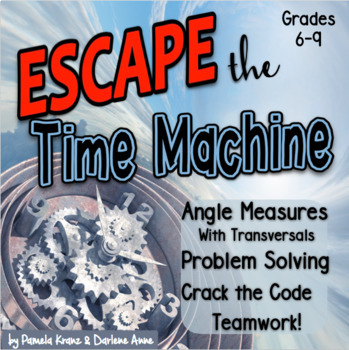Geometry Escape Room - Angle Measures, Transversals - Crack the Code
- Zip
What educators are saying
Description
If you’re looking for a fun, end of year geometry challenge, look no further! Escape the Time Machine is an engaging, team-building challenge that reviews angle measure rules for triangles and quadrilaterals, as well as the relationship between transversals and parallel lines.
This exciting time travel ESCAPE adventure begins when YOU - the most awesome teacher in the history of the world- plan a field trip to the Museum of Mathematics, where you just happen to run into an old friend known to many as the father of geometry. With a wave of his hand, Euclid ushers off your students, excited to show them time travel is indeed possible, and promises to have them back on time - he hopes.
Your kids will have to use every last ounce of their math smarts (apply the rules) to make it happen.
Using a comic format, kids embark on a journey where they complete a series of challenges: applying angle measure rules for triangles, quadrilaterals, and transversals. Their math knowledge and reading comprehension skills are the only tools they have that can fix the time machine and get back to the museum.
==========WHAT IS INCLUDED?==========
♦ At-a-glance instructions for EASY set up and organization.
♦ 6 tasks set up to use & apply rules for the following:
• Complementary & supplementary angles
• Missing interior angles in triangles and quadrilaterals
• Finding congruent angles formed from transversals
• Corresponding, alternate interior & exterior angles
• Computation practice (No protractors or other math tools are needed.)
• Problem-solving
• Using Greek and Latin affixes to name 3-D shapes (take away bookmark included).
♦ Crack the Code puzzle using all the aforementioned rules and skills to solve it.
♦ Building a dodecahedron from the answer circles.
♦ At-a-glance answers.
♦ Reflective exit slips.
♦ Awards to celebrate a successful escape.
==========WHAT DO I HAVE TO SUPPLY?==========
The Escape comic prints well in BW. (Included in the zip file - a folder for color printing and a folder for BW.) The files have been organized to save paper and make printing easy.
All that is needed is a few envelopes, folders, scissors and glue for completing the dodecahedron at the end. (This activity is optional, but they’re going to want to do it!) Unlike other break out activities, you don’t have to go out and buy expensive locks and boxes, because we’ve included everything you need to print and go!
==========WHAT MAKES THIS SPECIAL?==========
The storyline is interactive and immersive. YOUR students are directly involved in the story. If used as a pre-assessment or review, it will provide you with a perfect opportunity to discern where everyone is in their understanding of these concepts. All of our escapes resources are great to use for an observation.
==========HOW LONG DOES IT TAKE?==========
Completing the entire escape will take two 40-45 minute class periods. Students will not have to leave the room. This is NOT a scavenger hunt.
Have fun and be sure to come back for more escape room challenges!
This awesome resource is a collaboration between Darlene Anne and Pamela Kranz
Thanks for stopping by! Pam Kranz
***************************************************************************
© Pamela Kranz Desktop Learning Adventures All Rights Reserved




